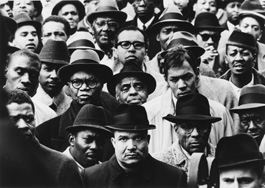home | metro silicon valley index | the arts | visual arts | review

Lent by The Capital Group Foundation, 2002.09 © 2006 The Gordon Parks Foundation
Watching History: Gordon Parks' gelatin silver print 'Black Muslim Rally' was taken in 1963 as
the black power movement began.
Parks Scene
A Gordon Parks retrospective at Stanford shows the depth of the pioneer photographer's vision
By Michael S. Gant
WITHIN A FEW feet of each other hang photographs so divergent that it hardly seems possible they were taken by the same person. A color fashion shot from 1962 shows a sleek blonde in a tight red dress posed between a red-framed door and a wall poster of an Art Deco chorine. Nearby in the Cantor Arts Center is a scarifying shot taken in a Rio de Janeiro favela of a young boy screaming in pain. The image comes from a 1961 Life magazine series about the extreme poverty afflicting a Brazilian family.
For Gordon Parks, these two extremes—the lovely goad to consumerism and the urgent documentary call for outrage—share a sensibility if not a subject. Both evince a rigorous eye for careful framing and precise lighting. The image of the favela boy is hardly a snapshot, even if it records a transitory moment. It looks deliberately like an echo of one of Goya's Disasters of War prints.
"Bare Witness" at the Cantor demonstrates the exceptional range of Parks, the pioneering African American photographer, film director (Shaft) and author (The Learning Tree), who died last year at the age of 94.
Parks, born in Kansas, took up fashion photography first; in the early 1940s, he chronicled the lives of poor families for the Farm Security Administration. From 1948 until 1972, Parks was perhaps the most notable of Life's photographers, producing major photo essays and writing the text to go with them.
The show offers myriad samples of Parks' visions in (mostly) gelatin silver print black-and-white photographs. The famous 1942 portrait of a Washington, D.C., washerwoman named Ella Watson posing with a broom and a mop in front of an American flag is titled American Gothic and makes an obvious ironic statement about Grant Wood's portrait of white middle America. Watson was real, but Parks' setup looks extremely calculated.
Like Dorothea Lange and Walker Evans before him, Parks made his name with powerful images of poverty in America. Tenement House, Ansonia, Connecticut (1949) shows a black family on the balcony of a run-down three-story building. Their circumstances are marginal, but the precise grid pattern created by the wood-slat railings and the narrow pillars is as formalist as a Mondrian.
Parks' photos of the Fontenelle family in Harlem in the late 1960s depict trash-strewn brick alleyways that might as well be prison yards. In Norman Jr. Reading in Bed, a young man lies on a bare mattress; the walls of his room are punctured with large gaps in the plaster. Parks' sense of social justice continued in the 1960s with resonant photographs of Malcolm X and Black Panther leaders Eldridge and Kathleen Cleaver.
In a very different vein, the exhibit demonstrates Parks' skill at celebrity portraiture, from Langston Hughes to Ingrid Bergman. His 1960 shot of a sad-eyed Duke Ellington at his piano, his image reflected in the propped-up lid, resembles the studio shots of Richard Avedon.
Among the many marvels here, two stand out. New England Family (1943) pinpoints several generations of one white family, proceeding from the head of an ancient woman in the foreground to a seated mother at the right to a wary young woman standing at the left to a woman and two children in the far background. The image has a zigzagging energy, heightened by the deep focus—it could be a tableau from Orson Welles' The Magnificent Ambersons.
Drinking Fountains, Birmingham, Alabama (1956) shows a young African American woman in her Sunday-best dress stopping in front of a store to take a sip from a drinking fountain marked in large letters "Colored Only." A little girl (her sister? daughter?) stands nearby, looking at the store window. Without forced editorializing, the image sums up the steeped-in indignities of the Jim Crow era. It's no surprise that almost 20 years later, Parks would pick up a movie camera and use it to exact some revenge in Shaft.
Bare Witness: Photographs by Gordon Parks runs through July 1 at the Cantor Arts Center, Stanford; 650.723.4177. The museum will screen 'Half Past Autumn: The Life and Works of Gordon Parks' on May 17 at 6pm, and 'Shaft' on May 18 at 7pm.
Send a letter to the editor about this story.
|
|
|
|
|
|